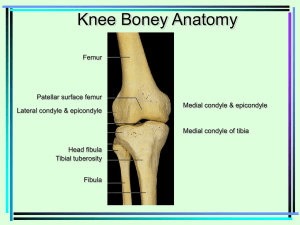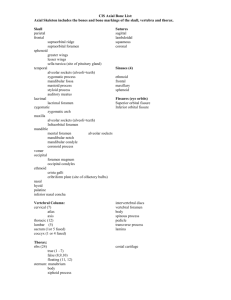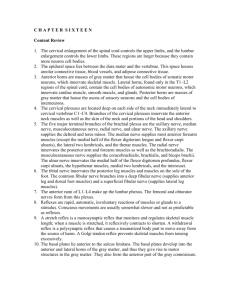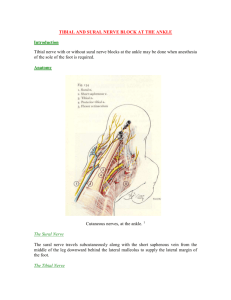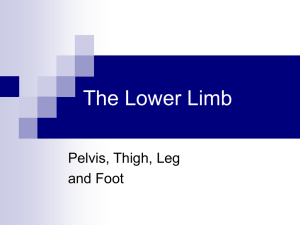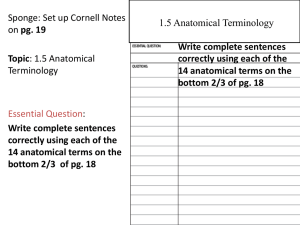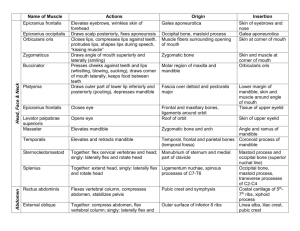UnitIIIMuscles
advertisement
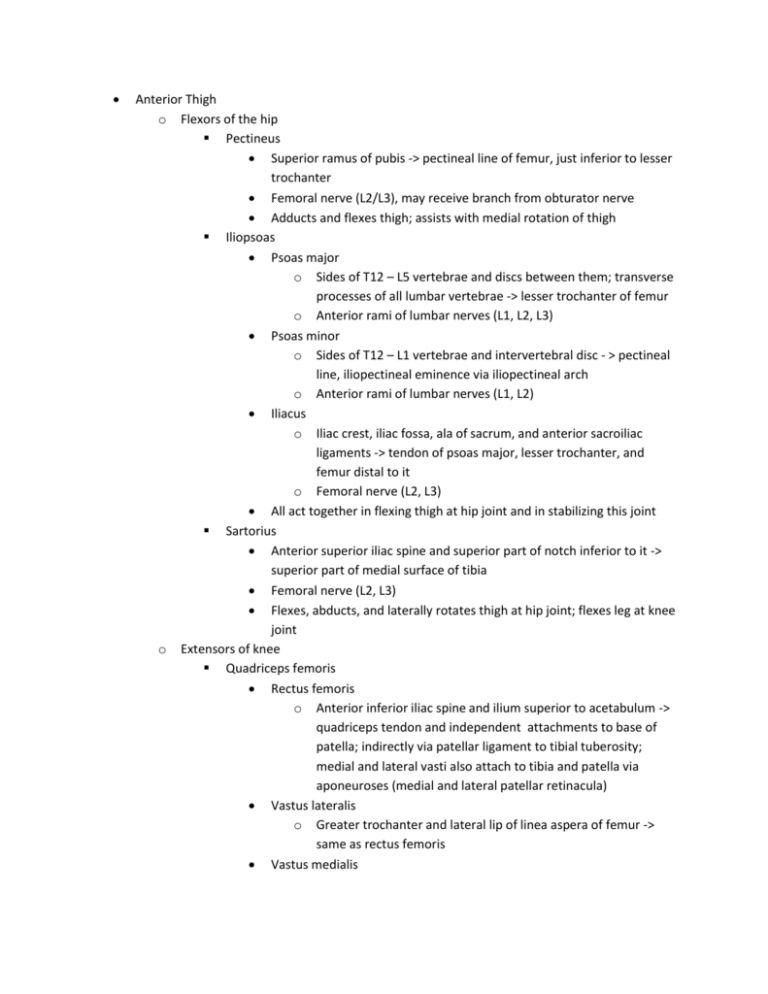
Anterior Thigh o Flexors of the hip Pectineus Superior ramus of pubis -> pectineal line of femur, just inferior to lesser trochanter Femoral nerve (L2/L3), may receive branch from obturator nerve Adducts and flexes thigh; assists with medial rotation of thigh Iliopsoas Psoas major o Sides of T12 – L5 vertebrae and discs between them; transverse processes of all lumbar vertebrae -> lesser trochanter of femur o Anterior rami of lumbar nerves (L1, L2, L3) Psoas minor o Sides of T12 – L1 vertebrae and intervertebral disc - > pectineal line, iliopectineal eminence via iliopectineal arch o Anterior rami of lumbar nerves (L1, L2) Iliacus o Iliac crest, iliac fossa, ala of sacrum, and anterior sacroiliac ligaments -> tendon of psoas major, lesser trochanter, and femur distal to it o Femoral nerve (L2, L3) All act together in flexing thigh at hip joint and in stabilizing this joint Sartorius Anterior superior iliac spine and superior part of notch inferior to it -> superior part of medial surface of tibia Femoral nerve (L2, L3) Flexes, abducts, and laterally rotates thigh at hip joint; flexes leg at knee joint o Extensors of knee Quadriceps femoris Rectus femoris o Anterior inferior iliac spine and ilium superior to acetabulum -> quadriceps tendon and independent attachments to base of patella; indirectly via patellar ligament to tibial tuberosity; medial and lateral vasti also attach to tibia and patella via aponeuroses (medial and lateral patellar retinacula) Vastus lateralis o Greater trochanter and lateral lip of linea aspera of femur -> same as rectus femoris Vastus medialis o Intertrochanteric line and medial lip of linea aspera of femur -> same as rectus femoris Vastus intermedius o Anterior and lateral surfaces of shaft of femur -> same as rectus femoris All innervated by femoral nerve (L2, L3, L4) All extend leg at knee joint; rectus femoris also steadies hip joint and helps iliopsoas flex thigh Medial thigh o Adductor longus Body of pubis inferior to pubic crest -> middle third of linea aspera of femur Obturator nerve, branch of anterior division (L2, L3, L4) Adducts thigh o Adductor brevis Body and inferior ramus of pubis -> pectineal line and proximal part of linea aspera of femur Obturator nerve, branch of anterior division (L2, L3, L4) Adducts thigh; flexes thigh to some extent o Adductor magnus Adductor part: inferior ramus of pubis -> gluteal tuberosity, linea aspera, medial supracondylar line Obturator nerve, branch of posterior division (L2, L3, L4) Adducts thigh; flexes thigh Hamstrings part: ischial tuberosity -> adductor tubercle of femur tibial part of sciatic nerve (L4) adducts thigh; extends thigh o gracilis Body and inferior ramus of pubis -> superior part of medial surface of tibia Obturator nerve (L2, L3) Adducts thigh; flexes leg; helps rotate leg medially Gluteal region o Gluteus maximus Ileum posterior to posterior gluteal line; dorsal surface of sacrum and coccyx; sacrotuberous ligament -> lateral condyle of tibia (iliotibial tract); gluteal tuberosity Inferior gluteal nerve (L5, S1, S2) Extends thigh (especially from flexed position) and assists in lateral rotation; steadies thigh and assists in rising from sitting position o Gluteus medius External surface of ilium between anterior and posterior gluteal lines -> lateral surface of greater trochanter of femur Superior gluteal nerve (L5, S1) Abducts and medially rotates thigh; keep pelvis level when ipsilateral limb is weight bearing and advance opposite side during its swing phase o Gluteus minimus External surface of ilium between anterior and inferior gluteal lines -> anterior surface of greater trochanter of femur Superior gluteal nerve (L5, S1) Abducts and medially rotates thigh; keep pelvis level when ipsilateral limb is weight bearing and advance opposite side during its swing phase o Tensor of fascia lata Anterior superior iliac spine; anterior part of iliac crest -> iliotibial tract, which attaches to lateral condyle of tibia Superior gluteal nerve (L5, S1) Abducts and medially rotates thigh; keep pelvis level when ipsilateral limb is weight bearing and advance opposite side during its swing phase o Piriformis Anterior surface of sacrum; sacrotuberous ligament -> superior border of greater trochanter of femur Branches of anterior rami S1, S2 Laterally rotate extended thigh and abduct flexed thigh; steady femoral head in acetabulum o Obturator internus Pelvic surface of obturator membrane and surrounding bones -> medial surface of greater trochanter (trochanteric fossa) Nerve to obturator internus (L5, S1) Laterally rotate extended thigh and abduct flexed thigh; steady femoral head in acetabulum o Superior and inferior gemelli Ischial spine (superior part); ischial tuberosity (inferior part) -> medial surface of greater trochanter (trochanteric fossa) Superior: nerve to obturator internus Inferior: nerve to quadratus femoris Laterally rotate extended thigh and abduct flexed thigh; steady femoral head in acetabulum o Quadratus femoris Lateral border of ischial tuberosity -> quadrate tubercle on intertrochanteric crest of femur and area inferior to it Nerve to quadratus femoris (L5, S1) Laterally rotates thigh; steadies femoral head in acetabulum Posterior thigh o Semitendinosus Ischial tuberosity -> medial surface of superior part of tibia Tibial division of sciatic nerve (L5, S1, S2) Extend thigh; flex leg and rotate it medially when knee is flexed; when thigh and leg are flexed, extends trunk o Semimembranosus Ischial tuberosity -> posterior part of medial condyle of tibia; reflected attachment forms oblique popliteal ligament Tibial division of sciatic nerve (L5, S1, S2) Extend thigh; flex leg and rotate it medially when knee is flexed; when thigh and leg are flexed, extends trunk o Biceps femoris Ischial tuberosity (long head), linea aspera and lateral supracondylar line of femur (short head) -> lateral side of head of fibula; tendon split at this site by fibular collateral ligament of knee Long head: tibial division of sciatic nerve (L5, S1, S2) Short head: common fibular division of sciatic nerve (L5, S1, S2) Flexes leg and rotates it laterally when knee is flexed; extends thigh (eg. When starting to walk) Anterior and lateral compartments of leg o Anterior compartment Tibialis anterior Lateral condyle and superior half of lateral surface of tibia and interosseus membrane -> medial and inferior surfaces of medial cuneiform and base of 1st metatarsal Deep fibular nerve (L4, L5) Dorsiflexes ankle and inverts foot Extensor digitorum longus Lateral condyle of tibia and superior three quarters of medial surface of fibula and interosseus membrane -> middle and distal phalanges of lateral four digits Deep fibular nerve (L5, S1) Extends lateral four digits and dorsiflexes ankle Extensor hallucis longus Middle part of anterior surface of fibula and interosseous membrane -> dorsal aspect of base of distal phalanx of great toe (hallux) Deep fibular nerve (L5, S1) Extends great toe and dorsiflexes ankle Fibularis tertius Inferior third of anterior surface of fibula and interosseous membrane > dorsum of base of 5th metatarsal Deep fibular nerve (L5, S1) Dorsiflexes ankle and aids in eversion of foot o Lateral compartment Fibularis longus Head and superior two thirds of lateral surface of fibula -> base of 1st metatarsal and medial cuneiform Superficial fibular nerve (L5, S1, S2) Everts foot and weakly plantarflexes ankle Fibularis brevis Inferior two thirds of lateral surface of fibula -> dorsal surface of tuberosity on lateral side of base of 5th metatarsal Superficial fibular nerve (L5, S1, S2) Superficial muscles of posterior leg o Gastrocnemius Lateral aspect of lateral condyle of femur (lateral head); popliteal surface of femur superior to medial condyle (medial head) -> posterior surface of calcaneus via calcaneal tendon Tibial nerve (S1, S2) Plantarflexes ankle when knee is extended; raises heel during walking; flexes leg at knee joint o Soleus Posterior aspect of head of fibula; superior quarter of posterior surface of fibula soleal line, medial border, and of tibia -> same as gastrocnemius Tibial nerve (S1, S2) Plantarflexes ankle independent of position of knee; steadies leg on foot o Plantaris Inferior end of lateral supracondylar line of femur; oblique popliteal ligament -> same as gastrocnemius Tibial nerve (S1, S2) Weakly assists gastrocnemius in plantarflexing ankle Deep muscles of posterior leg o Popliteus Lateral surface of lateral condyle of femur and lateral meniscus -> posterior surface of tibia, superior to soleal line Tibial nerve (L4, L5, S1) Weakly flexes knee and unlocks it by rotating femur 5° on fixed tibia; medially rotates tibia of unplanted limb o Flexor hallucis longus Inferior two thirds of posterior surface of fibula; inferior part of interosseous membrane -> base of distal phalanx of great toe (hallux) Tibial nerve (S2, S3) Flexes great toe at all joints; weakly plantarflexes ankle; supports medial longitudinal arches of foot o Flexor digitorum longus Medial part of posterior surface of tibia inferior to soleal line by a broad tendon to fibula -> bases of distal phalanges of lateral four digits Tibial nerve (S2, S3) Flexes lateral four digits; plantarflexes ankle; supports longitudinal arches of foot o Tibialis posterior Interosseous membrane; posterior surface of tibia inferior to soleal line; posterior surface of fibula -> tuberosity of navicular, cuneiform, and cuboid; bases of 2nd, 3rd, 4th metatarsals Tibial nerve (L4, L5) Plantarflexes ankle; inverts foot Muscles of foot o 1st layer Abductor hallucis Medial tubercle of tuberosity of calcaneus; flexor retinaculum; plantar aponeurosis -> medial side of base of proximal phalanx of 1st digit Medial plantar nerve (S2, S3) Abducts and flexes 1st digit (great toe, hallux) Flexor digitorum brevis Medial tubercle of tuberosity of calcaneus; plantar aponeurosis; intermuscular septa -> both sides of middle phalanges of lateral four digits Medial plantar nerve (S2, S3) Flexes lateral four digits nd o 2 layer Quadratus plantae Medial surface and lateral margin of plantar surface of calcaneus -> posterolateral margin of tendon of flexor digitorum longus Lateral plantar nerve (S2, S3) Assists flexor digitorum longus in flexing lateral four digits (toes) rd o 3 layer Flexor hallucis brevis Plantar surfaces of cuboid and lateral cuneiforms -> both sides of base of proximal phalanx of 1st digit Medial plantar nerve (S2, S3) Flexes proximal phalanx of 1st digit Adductor hallucis o Bases of metatarsals 2 -4 (oblique head); plantar ligaments of metatarsophalangeal joints (transverse head) -> tendons of both heads attach to lateral side of base of proximal phalanx of 1st digit Deep branch of lateral plantar nerve (S2, S3) Traditionally said to adduct 1st digit; assists in transverse arch of foot by metatarsals medially Dorsum Extensor digitorum brevis Calcaneus (floor of tarsal sinus); interosseous talocalcaneal ligament; stem of inferior extensor retinaculum -> long flexor tendons of four medial toes (digits 2-5) Deep fibular nerve (L5, S1) Aids the extensor digitorum longus in extending the four medial toes at the metatarsophalangeal and interphalangeal joints Extensor hallucis brevis Same as extensor digitorum brevis -> dorsal aspect of base of proximal phalanx of great toe (digit 1) Deep fibular nerve (L5, S1) Aids the extensor hallucis longus in extending the great toe at the metatarsophalangeal joint


